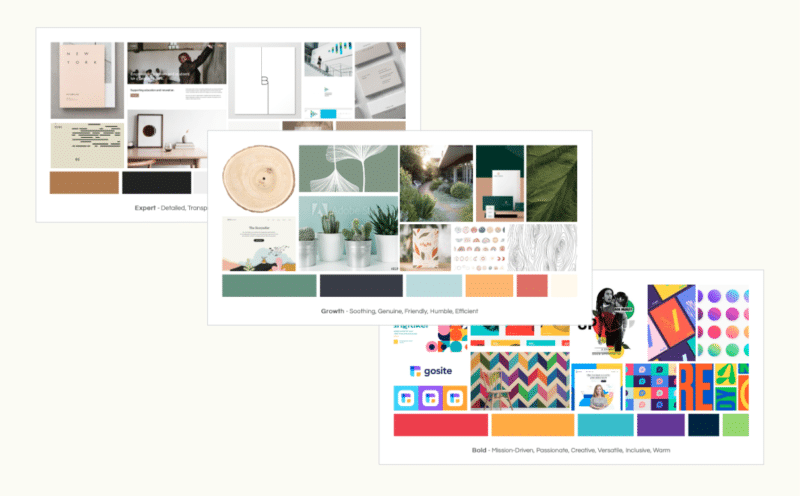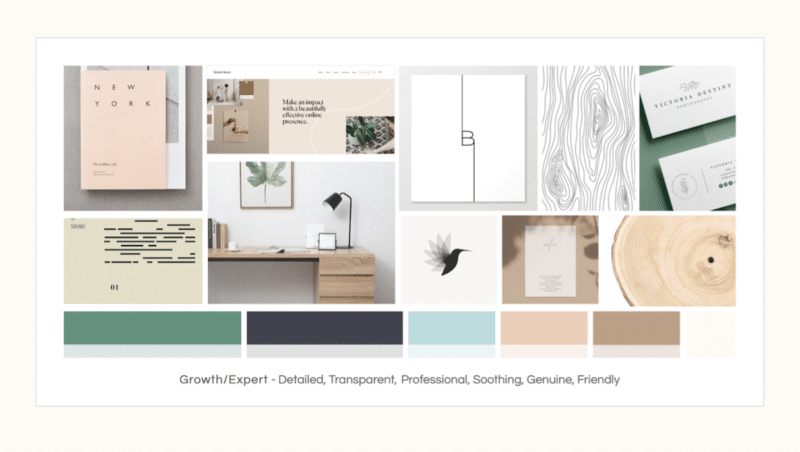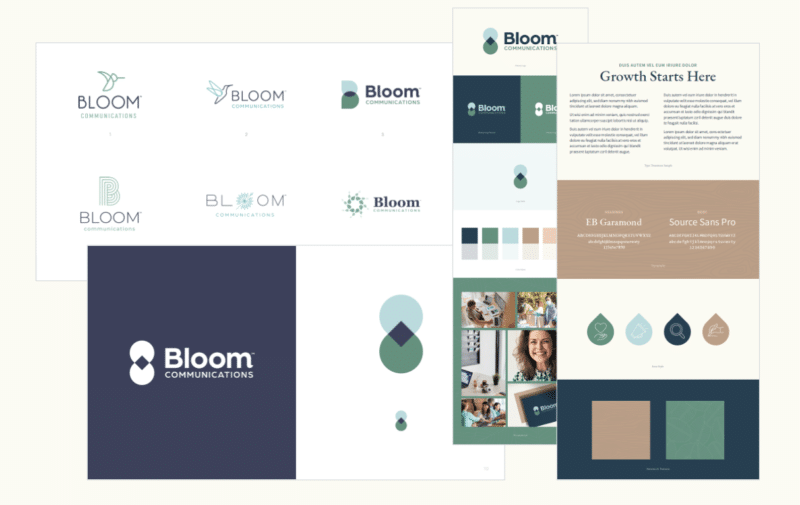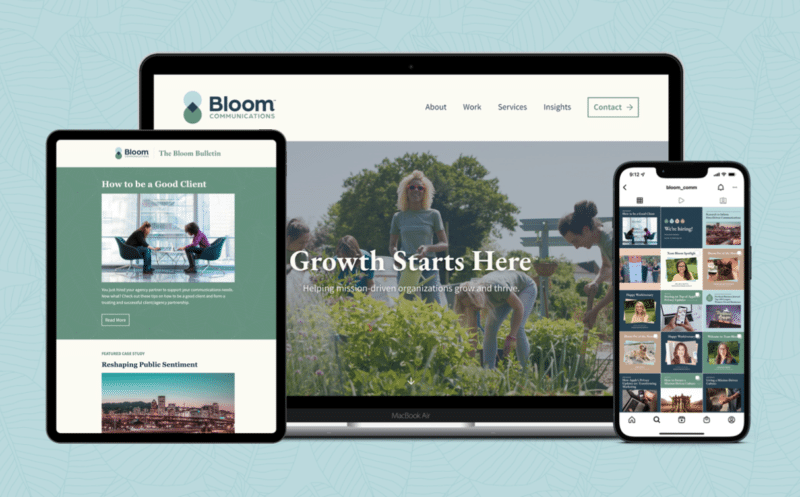In our recent blog, we explored the extensive research process we followed to revitalize our branding in 2021. We used the same tried and true methods we provide our clients to refine our brand strategy, positioning, and messaging. We conducted a thorough discovery and immersion exercise with our founder and executive team, followed by an in-depth internal and external audience research process to answer fundamental questions about Bloom:
Why do we exist? Why do we support mission-driven clients? What makes us who we are? How are we perceived? How can we better tell our story to provide an even greater impact in the world?
In this post, we’re going to explore how we used the answers to these difficult questions to refresh and launch our new visual identity through our 5-step creative process.
The Bloom Creative Process

Step 1: Discovery & Research Review
At Bloom, we use research and data to kickstart and guide all of our services and client work—even creative services. This ‘data-nerd’ approach to creativity might seem counterintuitive, but it removes a lot of guesswork and provides a common language around what could be a purely subjective process. What does the market research actually say and how does a creative solution trace back to the data?
For branding work, this means doing a deep dive into internal and external research to help understand what current or prospective audiences have to say about your company and similar organizations.
In our own brand research, we uncovered these key descriptors that define who we are, how our audiences perceive us, and how we wish to be perceived.

While it’s impossible to convey all of these ideas at all times, we use data-informed brand characteristics like these to help us align on visual tones and directions to explore throughout the creative process. This exercise creates alignment between the agency and client and serves as a lighthouse when the storm of personal opinions start to creep in and cloud the way. Trust the data. Trust the process.
Step 2: Creative Competitive Analysis
In today’s hyper-connected world, we are inundated with visual information and stimuli that are uniquely catered to our behaviors, preferences, and social connections. We are constantly served up more of what we like. So, to better understand how a brand can differentiate itself from all that visual noise, we have to explore the perceived bubble they exist in by asking, “How are competitors and similar organizations connecting with the same audiences as yours?”
In this step, we take a close look at the visual identity and brand positioning of your competitive landscape and use those insights to inspire a unique creative direction. We examine the logos, type treatments, colors, photos, videos, and any other visual elements to understand how all of these devices are working together to create a brand identity. What works, what doesn’t, and what can be improved?
We won’t go into the details of our own competitive assessment—but, this step was foundational in understanding how and where Bloom fits in among other service-oriented communications agencies. It helped us balance the objective and analytical data of step one with more subjective and creative visual references for comparison and inspiration.
Step 3: Mood Board Process
Here we begin to assemble and explore different visual directions that a branding project can go, based on the research and competitive analysis of the previous steps. Depending on the size and complexity of the project, we’ll create a series of visual mood boards that demonstrate potential creative solutions ranging from safely comfortable to adventurous. These mood boards consist of photographs, patterns, textures, fonts, icons, color palettes, design treatments, and any other visual media that help paint broad strokes of moods and tones for a creative project.
We then present these ‘look and feel’ directions to the client, gather feedback, and collaborate with them through an iterative process until we land on the right solution. Again, this step creates alignment with the client by including them as contributors in the process. It also serves as a guardrail to keep us all headed safely in the same direction.
For Bloom, we explored three mood board directions that accentuated different brand characteristics from step one and incorporated what we learned about our competitive landscape in step two.

After a series of discussions and revisions, we landed on an approach that positioned us as “Growth Experts” who are detailed, transparent, professional, soothing, genuine, and friendly.

Step 4: Design & Creative Development
And now, the real fun begins! Using everything we learned from steps 1-3, we finally start the hands-on creative work and begin to craft all the visual pieces of a new brand identity—including the logo, fonts, colors, icon design, patterns, photo style, etc.
Graphic design and creative services are very exciting fields of work…but they’re also very tedious. Brand identity work involves many internal explorations of tiny details before anything is shown to the client. I’ll spare you all of those intricacies and technical jargon, and jump right into the examples of our own branding explorations.
Here you can see a small snapshot of various logo design treatments and other brand elements coming together and taking shape.

After a series of refinements, revisions, blood, sweat, and tears, we finalize all the ingredients into a formal brand guidelines that we will use to move into the last step.
Step 5: Execution and Launch
Now that all the core brand elements have been thought through and crafted, the last step is consistently applying them across every touchpoint, channel, and collateral piece. This is always the most exhilarating and rewarding part of a rebrand—all of those weeks and months of prep work finally coming to fruition and pulling back the curtain for a grand entrance.
For Bloom, after many months of research, strategy, planning, and ideation, we finally redesigned everything about our identity from the ground up. This included our messaging platform, company logo, website, social assets, email marketing templates, sales presentations, client documents, print collateral, business cards, branded swag, and more.

After the Launch Party is Over
Now that we’ve walked through nearly every aspect of a rebranding project—from discovery to launch—it’s time to kick up our feet, sit back, and relax. We have a new logo, a new strategy, and a lot of new shiny marketing assets that are going to completely reshape our brand. Our work here is done.
…
Not quite.
Everything we’ve described so far is called “branding”—which, quite literally, is the process of trying to build a brand. Ultimately though, your brand is ever-changing because it is truly defined by your customers and audiences. It’s the emotional connection they have with your products and services at a given time. It’s not a logo, a tagline, a product, or a marketing campaign. All those items may help shape your brand, but in the end, your brand is unique to every single person who interacts with your company or organization. It’s your job to listen to them and try to uncover what the majority think and feel about your services as time goes on.
So, once you’ve celebrated all the hard work of branding (or rebranding) your company, it’s time to listen again, track the data, and continue to evolve as your audience also shifts and grows.
Need help along the way? We’re here to lend a hand.
